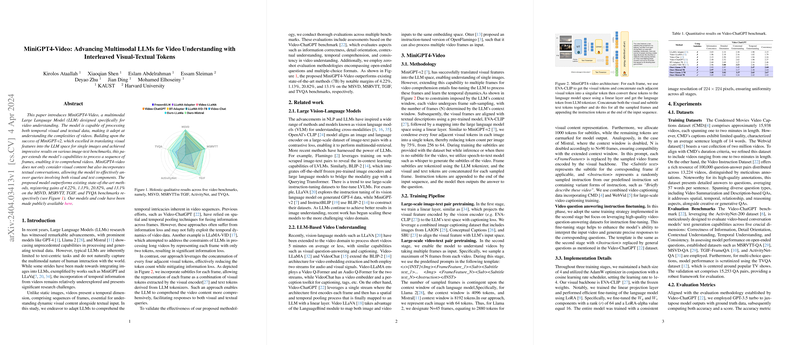Advancing Multimodal LLMs for Video Understanding: A Critical Analysis of MiniGPT4-Video
The paper "MiniGPT4-Video: Advancing Multimodal LLMs for Video Understanding with Interleaved Visual-Textual Tokens" introduces a significant advancement in multimodal LLMs designed specifically for video understanding. This paper builds upon the success of previous models such as MiniGPT-v2, extending its capabilities to interpret sequential frames within videos and comprehend their temporal dynamics effectively.
Key Contributions
The primary contribution of this work lies in its methodology for integrating temporal visual data and textual subtitles into a coherent model capable of handling video content. This is achieved through a novel token concatenation approach, which reduces token count while preserving information across frames. Key contributions of this paper include:
- Temporal Dynamics Consideration: The model addresses the complexities of video by concatenating every four adjacent visual tokens, thus efficiently reducing token count while maintaining information integrity.
- Interleaved Tokens: By incorporating subtitles for each frame, the model can represent frames as a combination of visual tokens from the visual encoder and text tokens from LLM tokenizers.
- Effective Training Pipeline: The authors implemented a multi-stage training pipeline, including pretraining on large-scale image-text pairs followed by video-text pair pretraining and instruction fine-tuning for video question answering.
Empirical Validation
The MiniGPT4-Video model was thoroughly evaluated against several benchmarks, demonstrating its efficacy with noteworthy results:
- Zero-Shot Evaluation: On benchmarks such as MSVD, MSRVTT, TGIF, and TVQA, the model exhibited substantial gains over existing state-of-the-art methods, achieving improvements of 4.22%, 1.13%, 20.82%, and 13.1% respectively.
- Video-ChatGPT Benchmark: The model outperformed prior methods in key evaluation metrics including Information Correctness, Detail Orientation, Contextual Understanding, Temporal Understanding, and Consistency. Specifically, the Llama 2-based version of MiniGPT4-Video showed marked improvements when subtitles were included.
Methodology
The paper delineates the methodology in detail, highlighting the use of EVA-CLIP for visual token generation and a linear layer mapping into the LLM space. The constraints of context windows (Llama 2 with 4096 tokens and Mistral with 8192 tokens) necessitate frame sub-sampling to ensure efficient processing.
For training, the paper adopts a three-stage process:
- Pretraining on Image-Text Pairs: Leveraging datasets like LAION and Conceptual Captions to align the visual features with the LLM.
- Video-Text Pair Pretraining: Applying predefined prompts to sampled video frames and their corresponding subtitles.
- Instruction-Finetuning: Exploiting high-quality video-question-answer datasets to enhance the model's capability for precise response generation.
Theoretical and Practical Implications
The implications of this research are multifaceted:
- Theoretical Advancement: The proposed methodology demonstrates the potential for multimodal LLMs to effectively parse and understand video content, paving the way for future research focused on long-form video comprehension.
- Practical Applications: MiniGPT4-Video can be utilized in a variety of applications, including video summarization, automated video captioning, and more sophisticated video query-answering systems.
Challenges and Future Directions
Despite its promising results, the current model is limited by the context window of the LLM, constraining video lengths to a maximum of 45 frames for Llama 2 and 90 frames for Mistral. Future work should investigate techniques to extend these capabilities to longer video sequences. Additionally, enhancing the integration of multimodal data, such as audio and other sensory inputs, could further enrich the model's understanding and performance.
Conclusion
In conclusion, MiniGPT4-Video represents a significant step forward in the domain of video understanding through multimodal LLMs. By efficiently interleaving visual and textual tokens, the model sets a new benchmark for video comprehension tasks. The method's robustness, as evidenced by empirical results, coupled with its theoretical innovations, provides a strong foundation for advancing AI capabilities in multimedia content analysis. Future research should focus on overcoming current limitations, ensuring broader applicability and enhanced performance in real-world scenarios.
